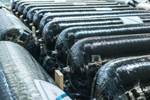Hexagon Purus signs multi-year global agreement for type IV composite hydrogen cylinders
Agreement covers the supply of composite pressure vessels for Air Liquide and its global affiliates.

Photo Credit: Hexagon Purus
Hexagon Purus (Ålesund, Norway) has signed a global supply agreement with Air Liquide (Paris, France), a leader in gases, technologies and services. The agreement covers the supply of type IV composite hydrogen cylinders to Air Liquide and its global affiliates. The cylinders will be used for transport of hydrogen for industry and mobility.
Hexagon Purus notes that the global agreement designates its as a long-term partner. The company plans to pursue further opportunities within the Air Liquide Group, and in conjunction, has already entered its first local supply agreement with an Air Liquide affiliate in a key region that is adopting hydrogen as a major part of its energy transition.
Hexagon Purus notes that, with the recent surge in activity around hydrogen driven by global policies and projects, there is growing interest in cost-effective solutions to transport it. Hexagon Purus contends that its lightweight composite cylinders are among the most efficient hydrogen gas transport cylinders available worldwide. The cylinders are said to enable very high payloads which reduces the environmental footprint of gas transport, and reduces the total cost of ownership for gas suppliers.
“Hydrogen has a crucial role to play in reducing harmful greenhouse gas emissions and combating global warming. To realize the full potential of hydrogen in the energy transition, we need to scale up the hydrogen ecosystem globally,” says Michael Kleschinski, EVP Light Duty, Distribution & Cylinders, Hexagon Purus. “We are proud to be selected as a partner by Air Liquide, a global leader in this arena, to support the delivery of hydrogen for customers and projects around the world.”
Related Content
-
Drag-based wind turbine design for higher energy capture
Claiming significantly higher power generation capacity than traditional blades, Xenecore aims to scale up its current monocoque, fan-shaped wind blades, made via compression molded carbon fiber/epoxy with I-beam ribs and microsphere structural foam.
-
NCC reaches milestone in composite cryogenic hydrogen program
The National Composites Centre is testing composite cryogenic storage tank demonstrators with increasing complexity, to support U.K. transition to the hydrogen economy.
-
Novel composite technology replaces welded joints in tubular structures
The Tree Composites TC-joint replaces traditional welding in jacket foundations for offshore wind turbine generator applications, advancing the world’s quest for fast, sustainable energy deployment.












.jpg;maxWidth=300;quality=90)
